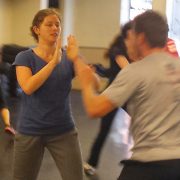Shadowboxing
/in Blog, Writing /by PeterShadowboxing is one of the most under-appreciated means a student can use to improve their fighting skills. Most often it us used as part of a warm-up, and rightly so. Students can move at their own pace and choose any moves they want, simulating any movements needed in a fight or in the upcoming class. To get the most out of shadowboxing, try approaching with the idea that it can be much more than a warm-up, and can significantly improve your movement and fighting skills.
No one is telling you exactly what to do and you have no opponent. Managing yourself and your movements allows you to experiment and be honest with yourself. Don’t worry about looking awkward or hesitant, just mentally stay within yourself, and use imagination to experiment with various situations and sequences of movement. When you become comfortable with more movement sequences, the more smooth you become, and the more easily you can recall and rely on them in an actual fight.
Under stress, movement becomes restricted and tighter, and it is likely that the stress will interfere with the feedback loop between your mind and body. At these times it is most helpful to have good muscle memory, so that you can perform effectively even while stressed. It is also helpful to be able to remain focused on the task at hand; ie. survival, and continue to send commands to your body with the expectation that these commands will be fulfilled capably. Shadowboxing helps keep the mind focused and movements can be tried that over time become forged into new and improved muscle memory.
Here are some examples of how to use realistic movements in shadowboxing. There are several scenarios of movement you can expect to see play out in a fight. I’ve chosen 4 of them.
1: Circling and striking an opponent who is momentarily stationary.
2: Following and striking an opponent who is circling away.
3: Evading and striking an opponent that is charging in.
4: Evading attacks at an angle and turning back in to strike.
The only other one is following and striking an opponent who is going straight back, and you should work on this also but it is probably the easiest.
Using an “X” on the floor, you can set up and play out all of these scenarios of movement. Don’t forget to use a variety of evasive and defensive movements mixed together with combatives. Give yourself the freedom to be creative, use correct footwork and posture, and resolve sticking points in your capabilities. Focus on the task at hand. The more often you train like this, the more you can expect these results to carry over into your fighting ability.
Body language
/in Blog, Writing /by PeterYou are always displaying some form of body language whether you are aware of it or not, like it or not.
Strategic thinking
/in Blog, Writing /by Peterstra·te·gic adj.
1. Of or relating to strategy.
2.
a. Important or essential in relation to a plan of action: a strategic withdrawal.
b. Essential to the effective conduct of war: strategic materials.
c. Highly important to an intended objective: The staff discussed strategic marketing factors.
3. Intended to destroy the military potential of an enemy: strategic bombing.
I think we can all agree that definitions 2a and 2c are the most relevant to all of us. Some of us are more inclined to be strategic thinkers than others, but it ought to be of some interest to anyone who is concerned about personal safety.
In order to avoid situations where your personal safety is threatened, or to get out of them as best you can, strategic thinking is a skill we all need to work on. It can be learned like anything else. Another factor that might motivate you is this: the people that are out to get us in some way or another, generally use some kind of strategic thinking to select their targets as well. Obviously this might exclude random un-premeditated attacks and sudden violent outbursts, but there are still some strategic elements to those types of scenarios as well.
An example of a basic criminal strategy could be this: an aggressive thief wants to rob people of wallets, and so he selects a part of town and begins looking for people who satisfy several of his strategic criterion: they must be alone, appear to have some money, it’s a plus if the potential victim isn’t paying attention somehow (on a cell phone, listening to headphones), and it’s usually going to be at night time to avoid detection.
We have to maintain a counter strategy to this risky scenario. So much of it is common sense, but even the most savvy urban citizens among us have probably found themselves in a tight spot before. We ought to know where we’re going, who we’re meeting and when, exactly how to get there, not walk home alone if we’re too inebriated, and all the other things we wouldn’t want our sons and daughters doing. However, it can easily get more complicated, as in the case of multiple attackers, or situations where you might be protecting a friend, a child or spouse.
You can use games to develop your strategic thinking ability. Probably the most prolific intellectual example is chess. Of course the are many others, and sports are included. A good activity will encourage you to plan several moves ahead, and be enjoyable.
There are plenty of books on the subject, such as ancient texts from feudal times like Musashi’s “Go Rin No Sho” (Book of 5 Rings) or “The Art of War”. Nowadays, doing a search on Amazon for “strategic thinking” nets over 9000 results, many of them about business but also some interesting titles like “Strategic Thinking in Criminal Intelligence” or “The Art of Thinking”.
It’s usually no more than planning ahead, but it’s worth considering how strategic thinking could be used by you to avoid situations that could put you or your loved ones at risk. Prepare for the worst, hope for the best, and as M used to say to James Bond: “Always have an escape plan.”
APA: strategic. (n.d.). The American Heritage® Dictionary of the English Language, Fourth Edition. Retrieved October 01, 2006, from Dictionary.com web site: http://dictionary.reference.com/browse/strategic
Self awareness for training
/in Blog, Health, Safety, Self Defense, Writing /by Peter“Until you know what you do, you cannot choose to do otherwise.” Moshe Feldenkrais.



